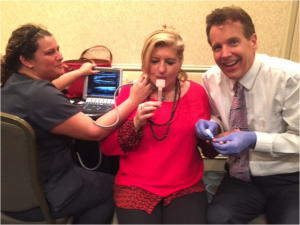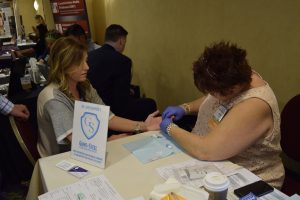2017 Testing Reveals AAOSH Members' CVD Risk
While reviewing all of the OralDNA test results for 2017, something really stood out like never before. We were seeing much higher levels of the high-risk oral pathogen Fusobacterium nucleatum than years before. F. nucleatum is one of five oral pathogens that have been identified as causative in the development of atherosclerosis by the Bale Doneen Vigerust 2016 study published in the British Medical Journal. Atherosclerosis, a disease that has killed more Americans than any other in the last century, can lead to heart attacks, strokes, and death. Preventive cardiologists Drs. Brad Bale and Amy Doneen have made it clear that they don’t want to see even the slightest presence of high-risks pathogens like F. nucleatum in their patients.
A Rise in F. Nucleatum Prevalence
In 2017, my Gums of Steel oral systemic testing team performed the OralDNA MyPerioPath saliva test on a total of 112 individuals. Out of that group, a total of 76 individuals had at least 80 percent or higher of the threshold level for F. nucleatum.
That's right: Over two-thirds of the healthcare professionals tested had high levels of atherosclerosis-causing F. nucleatum!
 So why the significant rise in this bacterium? Well, the OralDNA company revised their testing methods and increased the sensitivity to detect the presence P. gingivalis, T. denticola, and F. nucleatum. It seemed to me that this testing advancement really seemed to expose the presence of F. nucleatum because after reviewing result after result, it just seemed like most people had it. In fact, we noted the presence of the bacterium in 81 out of the 112 individuals we tested last year, and that was a whopping 72% of everyone that took the test! Hey, it’s time to sound the alarm because two thirds of us had the presence of the atherosclerosis-causing oral bacteria F. nucleatum!
So why the significant rise in this bacterium? Well, the OralDNA company revised their testing methods and increased the sensitivity to detect the presence P. gingivalis, T. denticola, and F. nucleatum. It seemed to me that this testing advancement really seemed to expose the presence of F. nucleatum because after reviewing result after result, it just seemed like most people had it. In fact, we noted the presence of the bacterium in 81 out of the 112 individuals we tested last year, and that was a whopping 72% of everyone that took the test! Hey, it’s time to sound the alarm because two thirds of us had the presence of the atherosclerosis-causing oral bacteria F. nucleatum!
If you haven’t had an OralDNA test taken in the last year or so, then you really do owe it to yourself to take another one now. With this new increased sensitivity, you may find levels of F. nucleatum lurking in your mouth that had previously been undetected—a dangerous risk factor that could have deadly consequences.
A Correlation with C-Reactive Protein?
In addition to OralDNA salivary diagnostic tests, we also performed HeartSmart blood tests, which test for C-reactive protein (CRP) among a few other biomarkers.
A CRP of 1.0 or higher is an indication to be on the lookout for controlling all sources of systemic inflammation. Any CRP test score over 3.0 denotes a high risk for the likelihood of a cardiovascular health event. Health care providers in the oral-systemic community should pay attention to CRP scores even if the patient is at moderate risk score of 1.0 up to 3.0 The detection of this early risk may prevent a serious cardiovascular health event.
In our group of testers, a total of 41 testers had a CRP of 3.0 or higher! That’s almost 50% screening high risk for a serious cardiovascular event such as a heart attack or a stroke. We noted that 85% of all of the CRP tests we took scored 1.0 or higher.
Our 2017 research also examined the results of the 85 individuals who took both an OralDNA test along with a HeartSmart blood test. In that group, all but one individual who had a high level of F. nucleatum also had a moderate- to high-risk C-reactive protein (CRP) score (above 1.0).
 All but seven of the 41 individuals who had a CRP of 3.0 or higher had a F. nucleatum concentration of 80% or more of the threshold level set by OralDNA. Scores like these (3.0 and up) should be brought to the immediate attention of a primary care physician because the body’s internal inflammation is too hot, and that can place the patient at a high risk for heart attack. Even worse, we found seven patients who had a CRP score of 10+ and all seven of those patients had an F. nucleatum level of 80% of threshold or higher.
All but seven of the 41 individuals who had a CRP of 3.0 or higher had a F. nucleatum concentration of 80% or more of the threshold level set by OralDNA. Scores like these (3.0 and up) should be brought to the immediate attention of a primary care physician because the body’s internal inflammation is too hot, and that can place the patient at a high risk for heart attack. Even worse, we found seven patients who had a CRP score of 10+ and all seven of those patients had an F. nucleatum level of 80% of threshold or higher.
It should be noted that a high CRP score is not directly correlated with a high concentration of F. nucleatum. There are a variety of systemic factors that can contribute to an individual’s C-reactive protein score, but the correlation in this instance is interesting.
Putting it All Together
Our 2017 testing pool found that the average level of F. nucleatum on all the testers was at 84.9% of the threshold level while the average CRP was 3.8. We even threw out the one person who scored a 121 CRP score, thinking that would really throw off the average. Even still, it’s frightening to think that the average AAOSH health professional’s blood test taken in 2017 screened at a high risk for heart attack. Yikes!
In comparison to 2016, the average F. nucleatum level was 72.7% of threshold and the average CRP score was 3.9. So we saw an increase of 12 percentage points of the F. nucleatum levels in 2017 vs. 2016 and no significant difference in the CRP. Since the beginning of 2017, the increased detection of F. nucleatum combined with it being newly tagged as a high-risk pathogen makes it a little devil to be reckoned with!. It’s worthy of our watchful eye (testing!), and its presence deserves our most intense therapeutic efforts—because, if left alone, it can be a killer!
